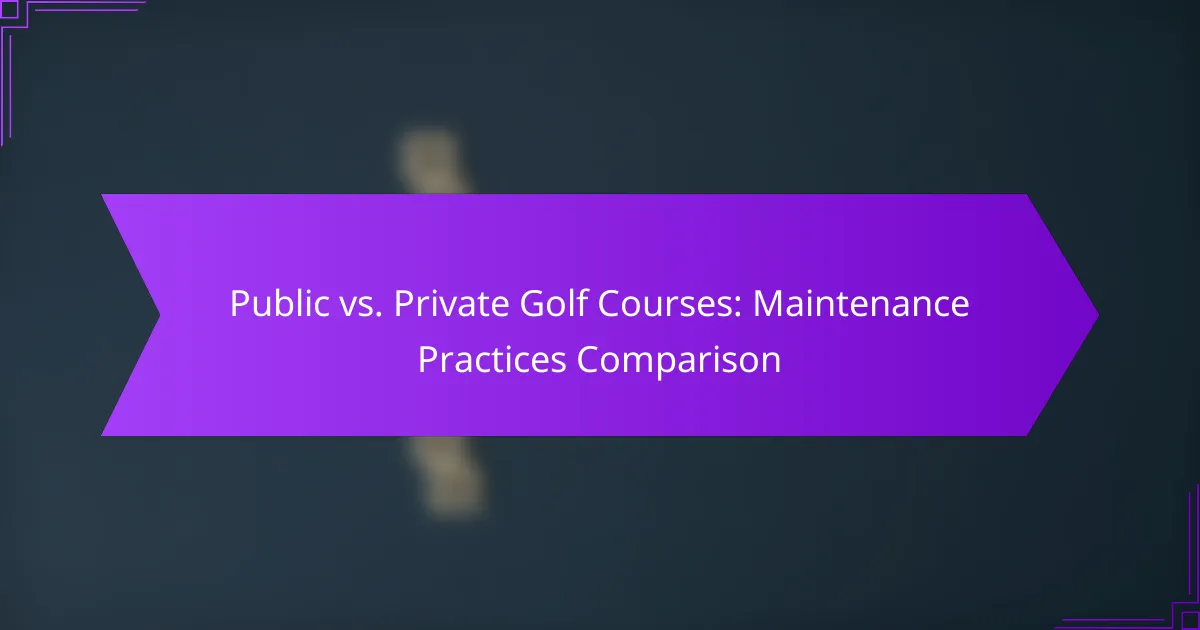The maintenance practices of public and private golf courses in the United States reveal distinct differences shaped by budget constraints and quality priorities. Public courses typically implement systematic maintenance routines focused on essential tasks to ensure playability, while private courses invest in advanced techniques and customized care to achieve optimal conditions. Understanding these variations highlights the impact of resources on the overall golfing experience.

What are the maintenance practices of public golf courses in the United States?
Public golf courses in the United States typically follow systematic maintenance practices to ensure course quality and playability. These practices include regular mowing, fertilization, pest control, irrigation management, and aeration techniques tailored to the needs of the course and its budget.
Regular mowing schedules
Regular mowing is crucial for maintaining the health and appearance of the grass on public golf courses. Most courses aim to mow greens at least two to three times a week, while fairways may be mowed once a week or more frequently during peak growing seasons.
Courses often adjust mowing heights based on the type of grass and seasonal conditions. For instance, during hotter months, a slightly higher cut can help retain moisture and reduce stress on the grass.
Fertilization and pest control
Fertilization practices on public golf courses are designed to promote healthy grass growth and resilience against pests. Typically, courses apply fertilizers several times a year, using both granular and liquid forms depending on the nutrient needs of the turf.
Pest control is equally important, with integrated pest management (IPM) strategies commonly employed. This may include regular inspections and targeted treatments to minimize the use of chemicals while effectively managing pests.
Irrigation management
Irrigation management is essential for maintaining turf health, especially in regions with variable rainfall. Public golf courses often utilize automated irrigation systems that can be programmed to deliver water based on weather conditions and soil moisture levels.
Courses may also implement practices such as using drought-resistant grass varieties and scheduling watering during cooler parts of the day to minimize evaporation. Regular system checks ensure efficiency and prevent overwatering.
Course aeration techniques
Aeration is a key maintenance practice that helps relieve soil compaction and improve air and water penetration. Public golf courses typically aerate greens and fairways at least once or twice a year, often during the spring or fall when grass is actively growing.
Common aeration techniques include core aeration and needle tining. Core aeration removes plugs of soil, while needle tining creates small holes to relieve compaction without removing soil. Both methods enhance turf health and promote better drainage.

What are the maintenance practices of private golf courses in the United States?
Private golf courses in the United States prioritize high-quality maintenance practices to ensure optimal playing conditions. These practices often involve customized turf management, advanced irrigation systems, exclusive landscaping features, and seasonal maintenance schedules that cater to the specific needs of the course.
Customized turf management
Customized turf management is essential for private golf courses, as it involves selecting the right grass types and maintenance techniques tailored to the local climate and soil conditions. This often includes soil testing and the application of fertilizers and pesticides based on specific turf health needs.
Courses may employ agronomists or turf specialists to develop a comprehensive management plan that addresses issues such as disease control, pest management, and nutrient application. Regular monitoring and adjustments ensure the turf remains healthy and resilient throughout the year.
Advanced irrigation systems
Advanced irrigation systems are a hallmark of private golf course maintenance, allowing for precise water application tailored to the needs of different areas of the course. These systems often include smart controllers that adjust watering schedules based on weather conditions and soil moisture levels.
Many private courses utilize technologies such as drip irrigation and underground sprinklers to minimize water waste and promote healthy grass growth. This not only conserves water but also helps maintain consistent playing conditions across the course.
Exclusive landscaping features
Private golf courses often incorporate exclusive landscaping features that enhance the aesthetic appeal and playability of the course. This can include strategically placed trees, flower beds, and decorative water features that complement the natural surroundings.
Maintaining these landscaping elements requires regular upkeep, including pruning, mulching, and seasonal planting. The goal is to create a visually stunning environment while ensuring that these features do not interfere with play.
Seasonal maintenance schedules
Seasonal maintenance schedules are critical for private golf courses to adapt to changing weather conditions and turf needs throughout the year. These schedules typically include aeration, overseeding, and topdressing during the growing season, as well as winterization practices to protect the course during colder months.
Courses may also implement specific maintenance tasks based on regional climate patterns, ensuring that the turf remains in peak condition regardless of seasonal challenges. Regular assessments help identify any necessary adjustments to the maintenance plan, ensuring optimal conditions for golfers year-round.

How do public and private golf course maintenance practices differ?
Public and private golf courses differ significantly in their maintenance practices, primarily due to budget constraints, quality of turf management, frequency of maintenance tasks, and the use of technology. Public courses often operate with tighter budgets, which can impact the overall quality and frequency of maintenance compared to private facilities that may have more resources available.
Budget constraints on public courses
Public golf courses typically face strict budget limitations, which can affect their maintenance practices. Funding often comes from green fees and local government support, leading to a focus on cost-effective solutions. As a result, public courses may prioritize essential maintenance tasks over luxury enhancements.
In contrast, private courses usually have higher membership fees that provide a more substantial budget for maintenance. This allows for more comprehensive care, including specialized staff and premium materials, ensuring a consistently high-quality playing surface.
Quality of turf management
The quality of turf management on public courses can vary widely, often depending on available funding and staff expertise. Many public courses may use basic maintenance techniques, which can lead to uneven playing conditions. Limited resources may also restrict the use of high-quality seed and fertilizers.
Private courses, however, often employ advanced turf management practices, including soil testing and customized fertilization schedules. They typically have dedicated agronomists or turf managers who ensure optimal conditions for the grass, resulting in a superior playing experience.
Frequency of maintenance tasks
Public golf courses generally have a less frequent maintenance schedule due to budget constraints, which can lead to longer intervals between mowing, aeration, and other essential tasks. This can affect the overall condition of the course, particularly during peak playing seasons.
In contrast, private courses often maintain a rigorous maintenance schedule, performing tasks like mowing and fertilization more frequently. This regular upkeep helps to keep the course in pristine condition, catering to the expectations of their members.
Use of technology in maintenance
Public golf courses may have limited access to advanced maintenance technology due to budget restrictions. This can result in a reliance on traditional methods for tasks such as irrigation and pest management, which may not be as efficient or effective.
Private golf courses are more likely to invest in cutting-edge technology, such as GPS-guided mowers and automated irrigation systems. These technologies enhance efficiency and precision in maintenance tasks, contributing to a higher quality of turf and overall course conditions.

What factors influence golf course maintenance costs?
Golf course maintenance costs are influenced by several key factors, including labor, equipment, and environmental conditions. Understanding these elements can help course managers optimize their budgets and improve overall course quality.
Labor costs and staffing
Labor costs are a significant portion of golf course maintenance expenses, often accounting for around 30-50% of total costs. Staffing levels depend on the size of the course and the complexity of maintenance tasks, with larger courses typically requiring more personnel.
Courses may employ full-time staff or seasonal workers, with seasonal hiring peaking during the growing months. It’s essential to balance labor costs with the quality of maintenance to ensure the course remains playable and visually appealing.
Equipment and technology investments
Investments in equipment and technology can greatly impact maintenance costs. High-quality mowers, irrigation systems, and maintenance tools can range from thousands to tens of thousands of dollars, depending on the brand and features.
While initial costs may be high, investing in efficient technology can lead to long-term savings through reduced labor hours and improved turf health. Regular maintenance of equipment is also crucial to avoid costly repairs and downtime.
Seasonal weather impacts
Seasonal weather plays a critical role in golf course maintenance costs, as different climates require varying levels of care. For instance, courses in warmer regions may need more irrigation and pest control, while those in cooler areas might focus on winterization and frost management.
Understanding local weather patterns helps in planning maintenance schedules and budgeting for unexpected weather-related expenses. Courses may need to invest in additional resources during extreme weather events, such as droughts or heavy rainfall, to maintain course conditions.

What are the benefits of proper golf course maintenance?
Proper golf course maintenance is essential for ensuring optimal playing conditions, extending the lifespan of the course, and enhancing its visual appeal. Regular upkeep not only improves the experience for golfers but also protects the investment made in the course infrastructure.
Enhanced playing conditions
Well-maintained golf courses provide superior playing conditions, which can significantly impact a golfer’s performance. Key elements like consistent grass height, well-irrigated fairways, and properly maintained greens contribute to a smoother game. Regular aeration and topdressing can help maintain turf health and improve drainage, leading to better overall conditions.
Golf courses should aim for a maintenance schedule that includes frequent mowing, pest control, and fertilization. These practices ensure that the course remains playable throughout the season, minimizing disruptions due to poor conditions.
Increased course longevity
Proper maintenance practices can significantly extend the lifespan of a golf course. Regular inspections and timely repairs of irrigation systems, bunkers, and pathways prevent small issues from escalating into costly problems. Investing in quality materials and maintenance equipment also contributes to the durability of the course.
Courses that follow a proactive maintenance plan can expect to see their infrastructure last longer, ultimately saving money on renovations and replacements. For instance, maintaining a healthy root system through proper watering and aeration can prevent the need for costly re-sodding.
Improved aesthetic appeal
A well-maintained golf course is visually appealing, attracting more players and enhancing the overall experience. Healthy, lush grass, well-kept landscaping, and clear signage contribute to a positive first impression. Regular maintenance ensures that flower beds, trees, and shrubs are pruned and healthy, adding to the course’s beauty.
Courses should consider seasonal planting and landscaping updates to keep the aesthetic fresh and inviting. Additionally, maintaining clean water features and pathways can enhance the overall ambiance, making the course more enjoyable for all visitors.



